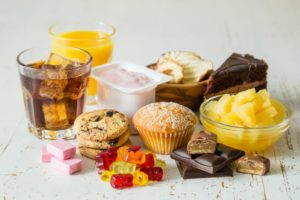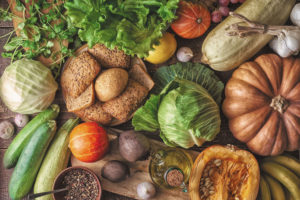Blog #11- Carb Killer
A Real ‘Who Dun’it’ Carb Killer? 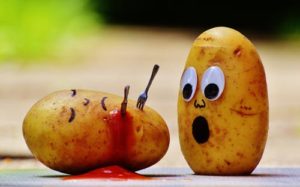
What a tragedy. Who could have done such a thing? Are there any suspects in this obvious crime? Are there witnesses? He didn’t have to go out like that! Did he suffer? Has anyone contacted the family? The [family] is going to be Fried! Just another senseless crime perpetuated on our carbohydrate friends. I heard some of the family got (s)mashed when they saw the pictures.
What do you mean no Carbs, low Carbs? I like Potatoes, bread, rice and pasta! As the trend towards low or no carbs continues it is important to know the importance of this macro nutrient. There is good and bad with anything.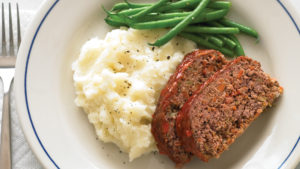
Like many Americans, I grew up in a family that wanted to ensure that we had enough to eat and especially at dinnertime. A square meal consisted of a starch, vegetable and a meat. A huge pot of spaghetti was served at least once a week and we are not Italian. Nor are we Irish or Asian, but potatoes and rice were the staples that made the meal. The inference here is to demonstrate that the American diet is indeed multicultural and standard. Meals were cooked at home and fast food was leftovers from a previous meal. There was no mention of carbohydrates. Having two starches at the same meal would have gotten you a raised eyebrow and reminder of having to shop in the ‘chubby’ section of the department store if the eating practice continued. Low Carb, No Carb? Is this a mere fad, a trend? Is this a diet or a lifestyle change?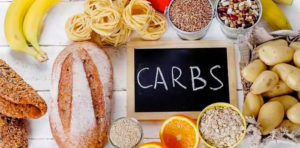
Wait there are three potential suspects in the kitchen now. I think they should be interviewed. Here are some popular eating alternatives that promote no and low carbohydrate options. Bring in the suspects- Paleo, Keto & Atkins
Atkins
- [You] Support and promote a low carbohydrate diet. Did you have a hand in this senseless crime? What do have to say?
- The Atkins diet was originally promoted by the physician Dr. Robert C. Atkins, who wrote a best-selling book about it in 1972. Hard to believe now, but the Atkins diet was shunned and demonized by the health industry as unhealthy and harmful because of the high saturated fats and proteins consumed, according to ‘Healthline internet mag’, in the form of meat, protein, fat.
- The Atkins diet has been shown to lead to more weight loss and greater improvements in blood sugar, “good” HDL cholesterol, triglycerides and other health markers than low-fat diets. Despite being high in fat, it does not raise “bad” LDL cholesterol, on average. Atkins does allow a gradual increase of some low carbs and here are four phases:
- Phase 1 (induction): Under 20 grams of carbs per day for 2 weeks. Eat high-fat, high-protein, with low-carb vegetables like leafy greens. This kick-starts the weight loss.
- Phase 2 (balancing): Slowly add more nuts, low-carb vegetables and small amounts of fruit back to your diet.
- Phase 3 (fine-tuning): When you’re very close to your goal weight, add more carbs to your diet until weight loss slows down.
- Phase 4 (maintenance): Here you can eat as many healthy carbs as your body can tolerate without regaining weight
Paleo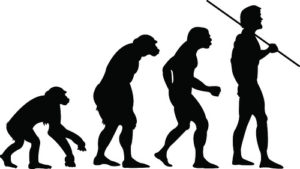
- [You] have supported the idea of eliminating some carbs, specifically Potatoes, as reported by the Mayo Clinic.
- This diet is mimicking the way humans ate during the Paleolithic age circa 10,000 years ago. The choice of food, is what was sought after and available by the “Hunters/Gathers”. This diet suggests more fresh, lean meats and fish, fruits and low carb veggies eaten daily. No grains, no legumes (beans) or dairy.
- It is believed by this research that, the human body is genetically mismatched to the modern diet that emerged with farming practices — an idea known as the discordance hypothesis. It is thought that the Farm emergence, outpaced the body’s ability to adapt. This mismatch is believed to be a contributing factor to the prevalence of obesity, diabetes and heart disease today. Mayo Clinic reported.
- A paleo diet is rich in vegetables, fruits and nuts — all elements of a healthy diet. The primary difference between the paleo diet and other healthy diets is the absence of whole grains and legumes, which are considered good sources of fiber, vitamins and other nutrients. Also absent from the diet are dairy products, which are good sources of protein and calcium. These foods not only are considered healthy but also are generally more affordable and accessible than such foods as wild game, grass-fed animals and nuts. For some people, a paleo diet may be too expensive.
 Keto
Keto
Ketogenic
- Supports and promotes a diet of low carbs– 50 grams or less per day- 5% or less of the diet. High Fat 60-80% and Protein 15-35%.
- Keto you have demonstrated how the reduction of carbs allows the body to go into Ketosis -“fat burning as a body fuel for energy rather than carbohydrates”. Personally, I have, as many others have, achieved significant weight loss following this plan. This diet has gained tremendous success.
- Keto sorry, you don’t
 have a long-range plan after the desired weight has been obtained. The selection of fats, protein and carbs can be ‘boring’. Deprivation, bored taste buds, too much fat, nutritional deficiencies, and the potential boomerang effect put this diet in last place, according to Edwina Clark, R.D., head of nutrition and wellness at Yummly- (A smart cooking sidekick app that learns what you like and customizes the experience to your personal tastes, nutritional needs, skill level, and more).
have a long-range plan after the desired weight has been obtained. The selection of fats, protein and carbs can be ‘boring’. Deprivation, bored taste buds, too much fat, nutritional deficiencies, and the potential boomerang effect put this diet in last place, according to Edwina Clark, R.D., head of nutrition and wellness at Yummly- (A smart cooking sidekick app that learns what you like and customizes the experience to your personal tastes, nutritional needs, skill level, and more). - Carbo-hydrates are stored in water, which means the initial weight loss is water. Carbon & water fuel the energy stores in the body. Without them you may feel irritable, grumpy, foggy.
- The Keto plan has the lowest restriction of carbs the experts say and I tend to agree. For me the diet just wasn’t sustainable after the desired weight was lost. I like fruit, bananas, apples, and more. I like yams, potatoes, butternut squash, & lately chickpeas as tuna! Yum.
Review of this Macro- Carbohydrates
Many Americans are scaling down from 40 years of low-fat, high carbohydrate eating. Label-reading has become a must at the market. We are determining what and how much of the three macro-nutrients we really need. Proteins, fats and carbohydrates are the nutrients the body requires to provide optimum endurance and strength. All are essential and further investigation is needed to develop your personal plan. Without being to exhaustive, let’s take a look at what we can safely say is the short list of the real culprits.
Simple carbs: refined sugar and processed foods. These were my personal favorites!
Potato Chips, Sugar Cookies, Artificial Juice Drinks, Soda, Bread/bagels, Muffins, Pretzels, Water ice, Cake, Pies
Complex ‘high carb’ Vegetables: Found in all fruits and vegetables, But, they have fiber and don’t race through the blood stream like candy or soda would to spike your insulin stores. Complex carbs take time to breakdown slowly in the digestive tract allowing for vitamin and nutrient uptake.
Quinoa, Oats, Barley, Potatoes, Beets, Yams, Couscous, 100% Whole wheat bread, Pumpkin, Brown rice, Basmati rice, Long grain rice, Lentils, beans
Complex ‘lower carb’ vegetables: (short list)
Broccoli, Asparagus, Spinach, Peppers, Zucchini, Carrots, Cauliflower, Kale, Mushrooms, Green beans, peas, Cucumbers, Onions, Tomatoes, Salad greens
Just a thought!
If you are considering a dietary shift, check with your physician and create a plan that is sustainable. The Atkins, Paleo, Keto plans have meat as a large part of the diet. If you are scaling back or have eliminated meat, these plans may not be for you.
Most fruits and vegetables contain carbohydrates. Carbs must be broken down into glucose (sugar) for the body to use it as energy. An entire sleeve of crackers or can of potato chips laced with trans fat, mono sodium glutamate, maltodextrine, and cottonseed oil can not provide the life-giving nutrients the body needs.
What’s your opinion on this topic?
Thanks for stopping by, Please leave a comment.
Go to The Source.
www.mayoclinic.org/healthy-lifestyle/nutrition-and-healthy-eating/in-depth/paleo-diet/art-20111182
https://www.safefood.eu/Healthy-Eating/The-Food-Pyramid-and-The-Eatwell-Guide/The-eatwell-plate/Breads,-cereals-and-potatoes.aspx
www.womenshealthmag.com/weight-loss/a19943910/high-protein-diets/
https://healthyeater.com/carb-protein-fat-rich-foods
https://www.healthline.com/nutrition/low-carb-diets-and-cholesterol
https://www.medicalnewstoday.com/articles/321545.php


